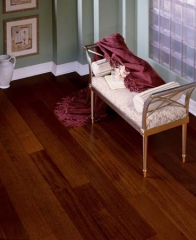Click and Lock Flooring
 Click and lock hardwood flooring, a type of floating floor, consists of attached planks suspended above a subfloor and resting on underlayment. Floating floors were originally glued together, but because that method can be messy, click and lock and lock and fold flooring allow boards to attach to each other without glue.
Click and lock hardwood flooring, a type of floating floor, consists of attached planks suspended above a subfloor and resting on underlayment. Floating floors were originally glued together, but because that method can be messy, click and lock and lock and fold flooring allow boards to attach to each other without glue.
99 percent of floating floors are engineered hardwood. All planks connect to each other form a large piece of hardwood that contracts and expands. Solid hardwood, on the other hand, contracts and expands too much. Engineered hardwoods, however, are composed of multiple pieces of natural wood glued together, and the grain on each layer faces a different direction. This feature allows engineered hardwood to be more stable in environments with moisture and heat.
No glue is involved for click and lock flooring. Instead, each plank is milled with a mechanized system that allows the flooring to stay in place once the tongue and groove are connected. The "click" aspect, however, is not fully accurate. Although some planks do make a clicking sound when attached, especially for laminate, engineered hardwoods need to be tapped together for the best fit.
Installation
If you are wondering about how to install click and lock flooring, first and foremost, always follow the directions on the packaging. Manufacturers each have their own guidelines: Some require glue and some do not, and others suggest using a hammer and tapping block. Before you install, thoroughly read the directions and make sure you have all tools and materials available.
The first step to installing click and lock flooring is underlayment. Manufacturers provide a three-in-one underlayment, which may have a moisture barrier on one side and foam cushioning on the other. After you roll out the underlayment, cut off any excess.
When you begin to install the planks, make sure your starting area is the largest parallel wall of the room and see that the first few rows are straight and gap free. Additionally, add scrap parts in the expansion area to keep boards aligned. As you add the flooring, go from left to right and space all starting boards 18 to 24 inches apart.
If your click and lock flooring requires glue, put a bead of it on top of the tongue and align the boards as close as possible by hand. Use a tapping block and hammer to get the tongue and groove as close together as possible. If any glue squeezes up, clean it off with a damp rag. However, if installation does not require glue, the boards may only need to be aligned and tapped together. Always check for gaps as you attach one board to the next.
By the time you get to the last piece, the plank will likely not fit. This piece needs to be fitted and should be cut where the tongues will face each other.


